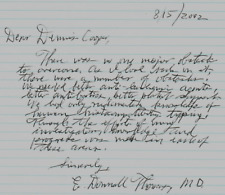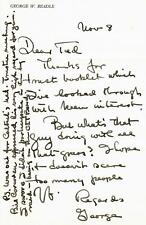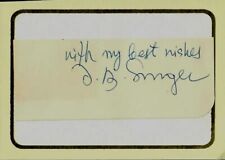

|
Site Categories |

|
Featured Items |

Poodle, Spaghetti Trim, Ucagco


|
\"Nobel Prize in Medicine\" H.G. Khorana Hand Signed 4X6 Album Page For Sale


When you click on links to various merchants on this site and make a purchase, this can result in this site earning a commission. Affiliate programs and affiliations include, but are not limited to, the eBay Partner Network.

\"Nobel Prize in Medicine\" H.G. Khorana Hand Signed 4X6 Album Page:
$399.99
Up for sale "Nobel Prize in Medicine" H.G. Khorana Hand Signed 4X6 Album Page. ES-6154E Har Gobind Khorana (9 January 1922 – 9 November 2011) was an Indian American biochemist. While on the faculty of the University of Wisconsin–Madison, he shared the 1968 Nobel Prize for Physiology or Medicine with Marshall W. Nirenberg and Robert W. Holley for research that showed the order of nucleotides in nucleic acids, which carry the genetic code of the cell and control the cell's synthesis of proteins. Khorana and Nirenberg were also awarded the Louisa Gross Horwitz Prize from Columbia University in the same year. Born in British India, Khorana served on the faculties of three universities in North America. He became a naturalized citizen of the United States in 1966, and received the National Medal of Science in 1987. Khorana was born to Krishna Devi Khorana and Ganpat Rai Khorana, in Raipur, a village in Multan, Punjab, British India in a Punjabi Hindu Khatri family. The exact date of his birth is not certain but he believed that it might have been 9 January 1922; this date was later shown in some documents, and has been widely accepted. He was the youngest of five children. His father was a patwari, a village agricultural taxation clerk in the British Indian government. In his autobiography, Khorana wrote this summary: "Although poor, my father was dedicated to educating his children and we were practically the only literate family in the village inhabited by about 100 people. The first four years of his education were provided under a tree, a spot that was, in effect, the only school in the village. He attended D.A.V. (Dayanand Anglo-Vedic) High School in Multan, in West Punjab. Later, he studied at the Punjab University in Lahore, with the assistance of scholarships, where he obtained a bachelor's degree in 1943 and a Master of Science degree in 1945. Khorana lived in British India until 1945, when he moved to England to study organic chemistry at the University of Liverpool on a Government of India Fellowship. He received his PhD in 1948 advised by Roger J. S. Beer The following year, he pursued postdoctoral studies with Professor Vladimir Prelog at ETH Zurich in Switzerland He worked for nearly a year on alkaloid chemistry in an unpaid position. During a brief period in 1949, he was unable to find a job in his original home area in the Punjab. He returned to England on a fellowship to work with George Wallace Kenner and Alexander R. Todd on peptides and nucleotides. He stayed in Cambridge from 1950 until 1952. He moved to Vancouver, British Columbia, with his family in 1952 after accepting a position with the British Columbia Research Council at University of British Columbia. Khorana was excited by the prospect of starting his own lab, a colleague later recalled. His mentor later said that the Council had few facilities at the time but gave the researcher "all the freedom in the world His work in British Columbia was on "nucleic acids and synthesis of many important biomolecules" according to the American Chemical Society. In 1960 Khorana accepted a position as co-director of the Institute for Enzyme research at the Institute for Enzyme Research at the University of Wisconsin at Madison. He became a professor of biochemistry in 1962 and was named Conrad A. Elvehjem Professor of Life Sciences at Wisconsin–Madison. While at Wisconsin, "he helped decipher the mechanisms by which RNA codes for the synthesis of proteins" and "began to work on synthesizing functional genes" according to the American Chemical Society. During his tenure at this University, he completed the work that led to sharing the Nobel prize. The Nobel web site states that it was "for their interpretation of the genetic code and its function in protein synthesis". Har Gobind Khorana's role is stated as follows: he "made important contributions to this field by building different RNA chains with the help of enzymes. Using these enzymes, he was able to produce proteins. The amino acid sequences of these proteins then solved the rest of the puzzle." He became a US citizen in 1966. Beginning in 1970, Khorana was the Alfred P. Sloan Professor of Biology and Chemistry at the Massachusetts Institute of Technology and later, a member of the Board of Scientific Governors at The Scripps Research Institute. He retired from MIT in 2007. Har Gobind Khorana married Esther Elizabeth Sibler in 1952. They had met in Switzerland and had three children, Julia Elizabeth, Emily Anne, and Dave Roy. Ribonucleic acid (RNA) with two repeating units (UCUCUCU → UCU CUC UCU) produced two alternating amino acids. This, combined with the Nirenberg and Leder experiment, showed that UCU genetically codes for serine and CUC codes for leucine. RNAs with three repeating units (UACUACUA → UAC UAC UAC, or ACU ACU ACU, or CUA CUA CUA) produced three different strings of amino acids. RNAs with four repeating units including UAG, UAA, or UGA, produced only dipeptides and tripeptides thus revealing that UAG, UAA, and UGA are stop codons. Their Nobel lecture was delivered on 12 December 1968. Khorana was the first scientist to chemically synthesize oligonucleotides. This achievement, in the 1970s, was also the world's first synthetic gene; in later years, the process has become widespread. Subsequent scientists referred to his research while advancing genome editing with the CRISPR/Cas9 system.

|
|
Related Items:
"Nobel Prize in Medicine" E Donnall Thomas Hand Written Letter COA $399.99

“Nobel Prize in Medicine" George Beadle Hand Written Letter COA $249.99

"Nobel Prize in Literature" Isaac Singer Clipped Signature Mounted $149.99
|
|


|
Shopping Cart  |

|
Recently Viewed |

|
Latest Items |

|
Facebook |
Secure Websites

|








